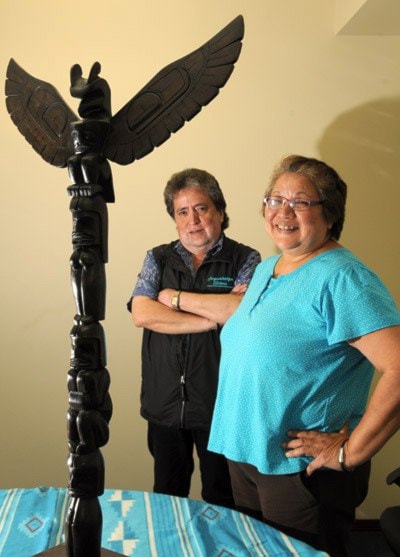The totem pole representing the B.C. Elders’ Gathering has been missing for six long years.
It recently resurfaced — just in time for Sto:lo communities to welcome thousands of aboriginal elders to the Fraser Valley.
When the 35th annual B.C. Elders’ Gathering opens Tuesday with a song and a prayer at The Tradex in Abbotsford, the portable black totem will once again preside over the event, to be bid on by aspiring host communities and to be safeguarded until the next gathering.
“It’s the official symbol of the elders’ gathering, so it has to take back its rightful place,” said Peter Lindley, coordinator of the Coqualeetza Elders’ group at the Coqualeetza Education Centre. “We’re telling everyone, ‘the totem pole has come home.’”
It was carved by Francis Horne Sr. for the first gathering in Sto:lo territory.
Now everyone is thrilled to hear the totem is back.
It turned out it was tucked away in a display cabinet with a Capilano elders’ group in North Vancouver.
“What I think happened, and it’s only a guess because no one seems to know for sure, is that the group which had the totem in its possession didn’t realize it was supposed to be passed on to the next host nation,” said Lindley. “Sometimes things change in communities and the knowledge gets lost.”
Historically the highlight of every elders’ gathering was bidding on the opportunity to host the next event, with the firm backing of one’s community. As part of that process there is a formal gift exchange between the reigning and future hosts, as well as the Elder King and Queen.
“Years ago someone must have thought the totem pole was one of those gifts to keep,” said Lindley.
It was presented to some Sto:lo community members last week.
“I was shocked that they were able to track the totem pole down. I was also ecstatic to hear that the people who had it were going to hand it over for the gathering,” said Halq’emeylem language teacher Wendy Ritchie, from Skowkale.
“I love that it brings us the history of each gathering. We can see where it’s been for the past 35 years.”
Sto:lo and Coast Salish communities on both sides of the border are hosting the three-day elders’ event with an estimated 4,000 elders and 1,000 chaperones and volunteers ready to meet at the Tradex in Abbotsford.
It all started in the 1980s when the Coqualeetza Elders’ group launched a discussion about the high drop-out and suicide rates among youth, and it grew into an annual event.
The totem pole functions as a record keeper with places and dates inscribed on small plaques at the base of it, recording each gathering’s details. The only events missing will be those from the past six years.
Ritchie designed the official logo for this year’s gathering, with a central spiral to represent time immemorial, along with some recognizable Sto:lo symbols. She’s also being honoured for her contribution, by being asked to sing the opening song and offer the opening prayer.
Elders take their place as advisors, teachers and leaders at the gathering, socializing and celebrating accomplishments as well as reinvigorating themselves for future work. They’ll share traditional ways with a variety of songs, dances and ceremonies throughout the event.
The elegant, black totem was carved by Francis Horne, Sr. out of pine that he later stained and polished to a high gloss.
He was asked by Shirley Leon from Coqualeetza to carve something symbolic for the first gathering more than 35 years ago.
“It’s pretty to cool to hear it’s back,” said the carver. “I was a young man when I carved it and I haven’t seen it for years.”
Horne will be at the Tradex this week to set eyes on the totem — for the first time in a long time.
jfeinberg@theprogress.com
twitter.com/CHWKjourno
